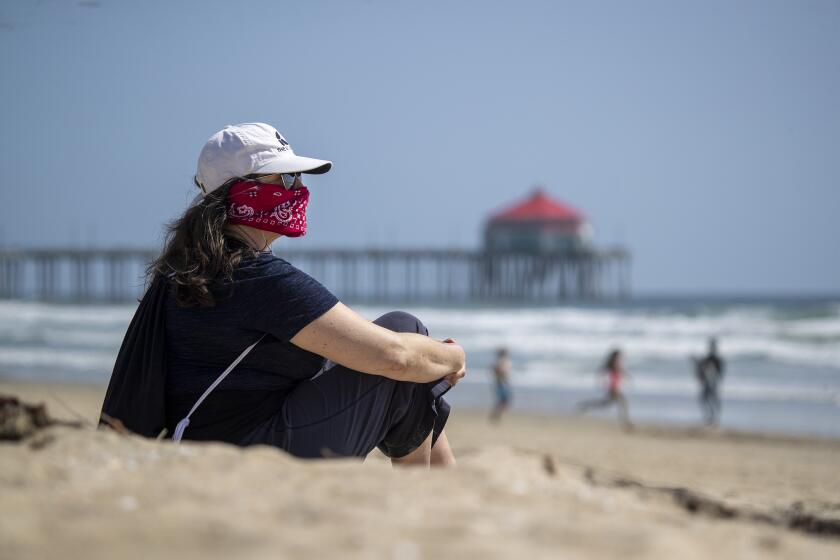In the Pipeline: Mysterious underwater outline has experts stumped
It’s a mystery that goes back at least to the mid-1980s, when a Sunset Beach diver named Greg Lacey first discovered what he called treasure tides.
As the Los Angeles Times described in 1986, Lacey had been discovering lots of loot in the predawn surf, including plenty of cold, hard (and wet) cash. Where did the money, shoes, wallets and blankets all come from? One Coast Guard captain chalked it all up to high tide or heavy rains flushing out debris from inland.
Lacey, who grew up in this area, today lives in Arizona along the Colorado River. But he never stopped thinking about the treasure tides and what might have caused them.
Not long ago, he was using Google Earth to survey the coastline of Huntington Beach and Sunset Beach in the hope that he might see some sort of vortex, or tidal pattern, that might have resulted in the phenomenon.
As a diver, he had worked on enough rigs and boats to understand that you never can be too sure about oceanic treasure. Part of him wondered if a ship might have been submerged out there, thus providing the source of the valuables.
But thanks to a new and more revealing version of the Google program, he saw something both peculiar and spectacular two miles out in the water from where Warner Avenue meets Pacific Coast Highway.
He contacted a number of established treasure-hunting divers — who showed little interest in his find, given the politics of what it would take to examine something in local waters.
Just what did he see?
To his eyes, Lacey was looking at “a sunken Spanish mission off our coast.” He could make out the fortress walls and even a bell tower above the sand.
More startling was the size. Although the primary structure is about three-quarters of a mile long, the entire complex is actually closer to two miles. Imagine five or six Empire State buildings set end-to-end and you have an idea of the span of this superstructure.
To me, Lacey’s theory seemed implausible. I reached out to my friend, the impossibly knowledgeable Planning Commissioner Mark Bixby, for his thoughts, and he concurred.
“Water depths appear to be on the order of 40 to 50 feet, according to NOAA [National Oceanic and Atmospheric Administration] charts, and there hasn’t been that much sea level rise since the mission era,” he said. “If it really was a Spanish mission, there would have been some record of it, since empires with enough resources to put outposts on the other side of the globe by nature tend to develop bureaucracies to keep track of things.”
But he added, “The feature is real because erosion is evident along the boundaries. It is awfully linear and right-angled to be a natural feature.”
Bixby also offered that it could be artificial reefs.
Marine biologist Marty Golden said there is “zero chance” the formation has anything to do with a Spanish mission.
“I am not a sea-level expert, but in last 200 to 300 years I think sea level has changed maybe a foot or so. I doubt if this area could have been above water in the last thousand years or so,” he said, adding that the mystery might be a dredge disposal area for the Seal Beach Naval Weapons Station or the ports of Long Beach and Los Angeles.
To gain additional information in this area requires permits, which I’m looking into.
Jim McKibben, director of the Science Learning Center at Cal State Long Beach, did not discount the Spanish mission theory.
“We know that some areas of the California coastal zone have been subject to liquefaction during past seismic events,” he said. “Liquefaction was a major factor in the destruction of the harbor of Alexandria, Egypt, following a major seismic event. Many of the harbor structures sank intact.”
McKibben is an expert on seismic events.
“I agree that the sea level hasn’t risen that much in the last several thousand years,” he added. “But with liquefaction, the sandy soil can flow down the slope of the coastal plane similar to the flow of a glacier. The sandy soil becomes quicksand and flows, taking any structures with it.”
And it wouldn’t be the first time he’s seen such a phenomenon.
“I have seen the sand cascade like this in La Jolla Submarine Canyon without the aid of seismic activity. Think of the collapse of coastal bluffs like La Conchita (Ventura County),” he added. “The soil became saturated with rain and fell away, burying homes beneath it. The difference is with a sand bluff, it would simply cascade seaward.”
He followed up with me several days later. “I looked up a couple references and found several that mentioned earthquake liquefaction for the general Huntington Beach area,” he said before explaining more about how a structure could actually have ended up two miles offshore.
Could a structure with no record of it having been built quietly slipped into the sea?
This is a mystery deeply intriguing to the experts to whom I have reached out. Nobody can look at this image and say exactly what it is.
For the treasure hunter, Lacey, who brought this to our attention, a hearty thanks.
Mysteries like this remind us of how much we don’t know.
Whatever this thing is, let us now begin the process of getting to the bottom of it.
CHRIS EPTING is the author of 19 books, including the new “Baseball in Orange County,” from Arcadia Publishing. You can chat with him on Twitter @chrisepting or follow his column at https://www.facebook.com/hbindependent.
All the latest on Orange County from Orange County.
Get our free TimesOC newsletter.
You may occasionally receive promotional content from the Daily Pilot.



